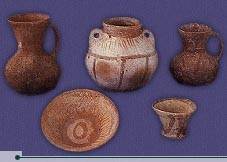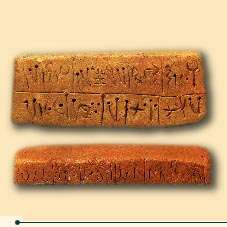 |
Keys
to the Kingdom National Anthem The Office History |
|
By about 3200 BCE, Jordan had developed a relatively urban character. Many settlements were established during the Early Bronze Age (c. 3200-1950 BCE) in various parts of Jordan, both in the Jordan Valley and on higher ground. Many of the villages built during this time included defensive fortifications to protect the inhabitants from marauding nomadic tribes still inhabiting the region. Water was channeled from one place to another and precautions were even taken against earthquakes and floods. |
 From burials, Early Bronze Age pottery. © T. Evans |
||
Interesting changes took place in burial customs during this period. At Bab al-Dhra, a well-preserved site in Wadi ‘Araba, archaeologists have discovered over 20,000 shaft tombs with multiple chambers, thought to have contained the remains of 200,000 corpses. There were also charnel houses of mud-brick containing human bones, pots, jewelry and weapons. The hundreds of dolmens scattered throughout the mountains of Jordan are dated to the late Chalcolithic and Early Bronze ages. It is possible that the dolmens are evidence of new peoples from the north bringing with them different burial traditions. Spectacular advances in urban civilization were taking place during this period in Egypt and Mesopotamia, where writing developed before 3000 BCE. Although writing was not really used in Jordan, Palestine and Syria until over a thousand years later, archeological evidence indicates that Jordan was in fact trading with Egypt and Mesopotamia. From 2300-1950 BCE, many of the large, fortified hilltop towns constructed during the Early Bronze Age were abandoned in favor of either small, unfortified villages or a pastoral lifestyle. Archaeologists do not know for sure what prompted this shift, but it is possible that many cities were destroyed by an earthquake. It is clear, however, that a sharp climatic change at this time resulted in less rainfall and higher temperatures across the Middle East. The predominant theory is that many of these Early Bronze Age towns were victims of changes in climate and political factors which brought an end to a finely-balanced network of independent "city-states." |
|||
During the Middle Bronze Age (c. 1950-1550 BCE), people began to move around the Middle East to a far greater extent than before. Trading continued to develop between Egypt, Syria, Arabia, Palestine and Jordan, resulting in the refinement and spread of civilization and technology. The creation of bronze out of copper and tin resulted in harder and more durable axes, knives and other tools and weapons. It seems that during this period large and distinct communities arose in parts of northern and central Jordan, while the south was populated by a nomadic, Bedouin-type of people known as the Shasu. A new and different type of fortification appeared at sites like Amman's Citadel, Irbid, Tabaqat Fahl (or Pella) and (Ariha) Jericho. The towns were surrounded by ramparts made of earth embankments. The slope was then covered in hard plaster, making it slippery and difficult for an enemy to climb. Pella was enclosed by massive walls and watch towers. It was once thought that during the 18th century BCE much of Syria, Jordan and Palestine were overrun by a military aristocracy from northern Mesopotamia known as the Hyksos, who went on to conquer much of Egypt and help overthrow the Middle Kingdom there. Now, however, archaeologists believe that the Hyksos -a Greek form of the ancient Egyptian hkaw haswt, which means "rulers of foreign lands"- were from Jordan and Palestine. We do know that the Hyksos brought with them the war chariot, horses and a new type of defensive architecture. Archaeologists usually date the end of the Middle Bronze Age to about 1550 BCE, when the Hyksos were driven out of Egypt by the rulers of the 17th and 18th Dynasties. The destruction of many of the Middle Bronze Age towns in Palestine and Jordan is usually blamed on the Egyptian armies pursuing the Hyksos, although there is little direct evidence of Egyptian involvement. The Egyptian Pharaoh Tuthmosis III, who acceded as ruler in 1482 BCE, succeeded in settling many of the internal disputes which had diverted Egypt's attention away from the outlying northern areas. He carried out at least 16 military expeditions and set up an empire in Canaan (Palestine, Jordan and Syria) after the successful conclusion of a seven-month siege of the combined Canaanite forces at Megiddo, in northern Palestine. Tuthmosis installed rulers of his choice in major towns and introduced a system of Egyptian governors in general control over administration of the province. A system of Canaanite city-states under varying degrees of Egyptian influence existed throughout Jordan and Palestine during this period. In the north, meanwhile, the Egyptians fought a series of inconclusive battles against the kingdoms of the Mitannians and Hittites for control of Syria. The relative peace brought by the Egyptians encouraged international trade, especially with the Mediterranean and Aegean. Pottery from Mycenaean Greece and Cyprus is found throughout Palestine and Jordan. Originally it probably contained fine oils and perfumes, but it was also used as elegant tableware or buried with the dead. In this relatively optimistic and prosperous period, a large number of new towns and temples were constructed. |
 Clay tablets; Late Bronze Age. © Ministry of Tourism & Antiquities |
The Late Bronze Age was brought to a mysterious end around 1200 BCE, with the collapse of many of the Near Eastern and Mediterranean kingdoms. The main cities of Mycenaean Greece and Cyprus, of the Hittites in Anatolia, and of Late Bronze Age Syria, Palestine and Jordan were destroyed. It is thought that this destruction was wrought by the "Sea Peoples" marauders from the Aegean and Anatolia who were eventually defeated by the Egyptian pharoahs Merenptah and Rameses III. One group of Sea Peoples were the Philistines, who settled on the southern coast of Palestine and gave the area its name. |
| The
Israelites may have been another cause of the Late Bronze Age devastation in Palestine.
Although the archeological record does not always agree with the Biblical narrative, it is
certain that the Israelites destroyed many Canaanite towns including Ariha (Jericho), Ai
and Hazor. One of the issues debated concerns the Kingdom of Edom (the area of Jordan south of the Dead Sea). The Book of Numbers states that the Israelites coming from Egypt found Edom a fully developed state. However, no Edomite settlements have been identified before the end of the 8th century BCE, and there was surely no "state" of Edom as early as 1200 BCE, when the Biblical conquest narrative is set. Some archaeologists believe that the "king" of Edom was a Bedouin sheikh, and that his "kingdom" would have left no noticeable ruins for archaeologists to find. |